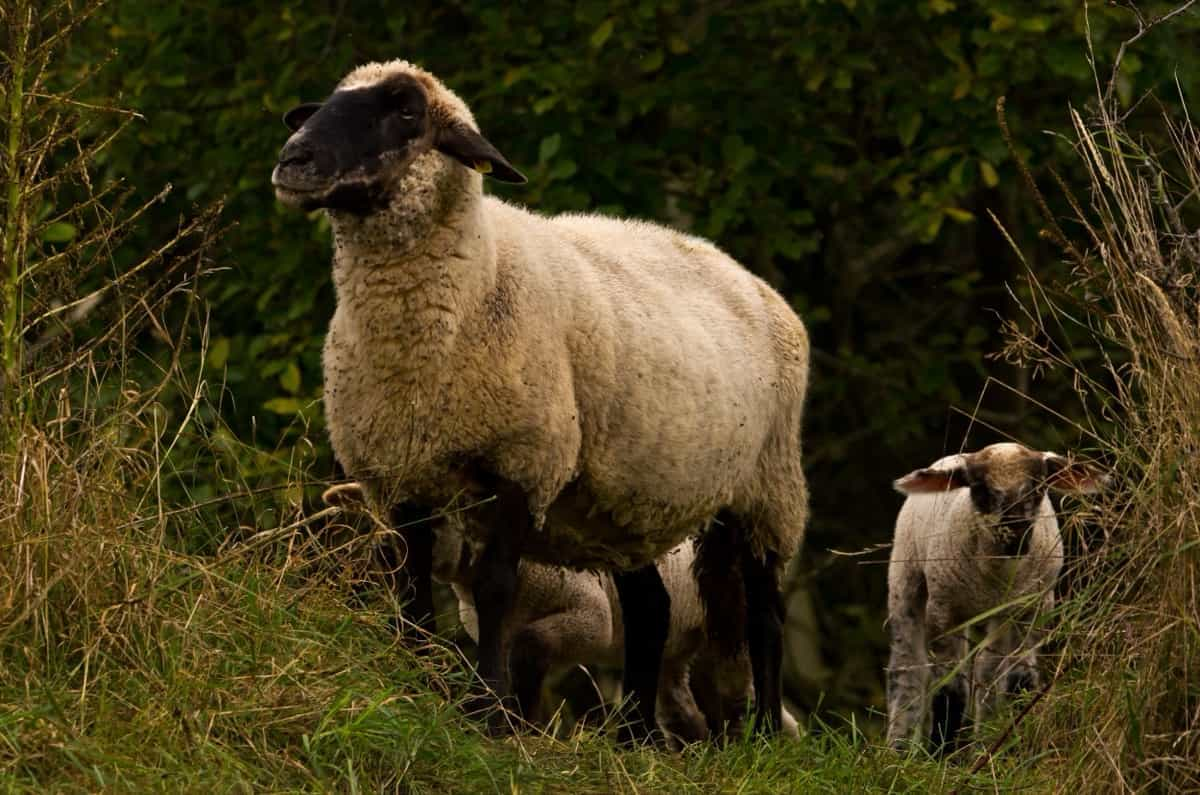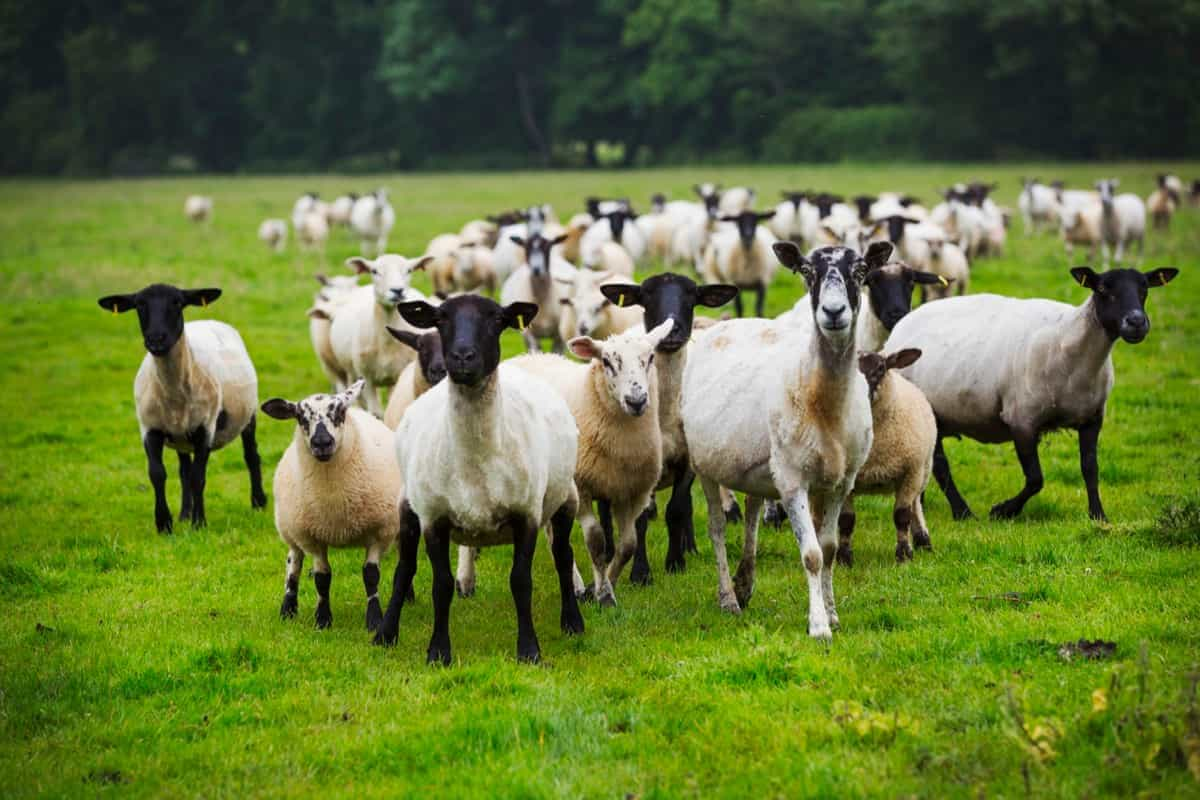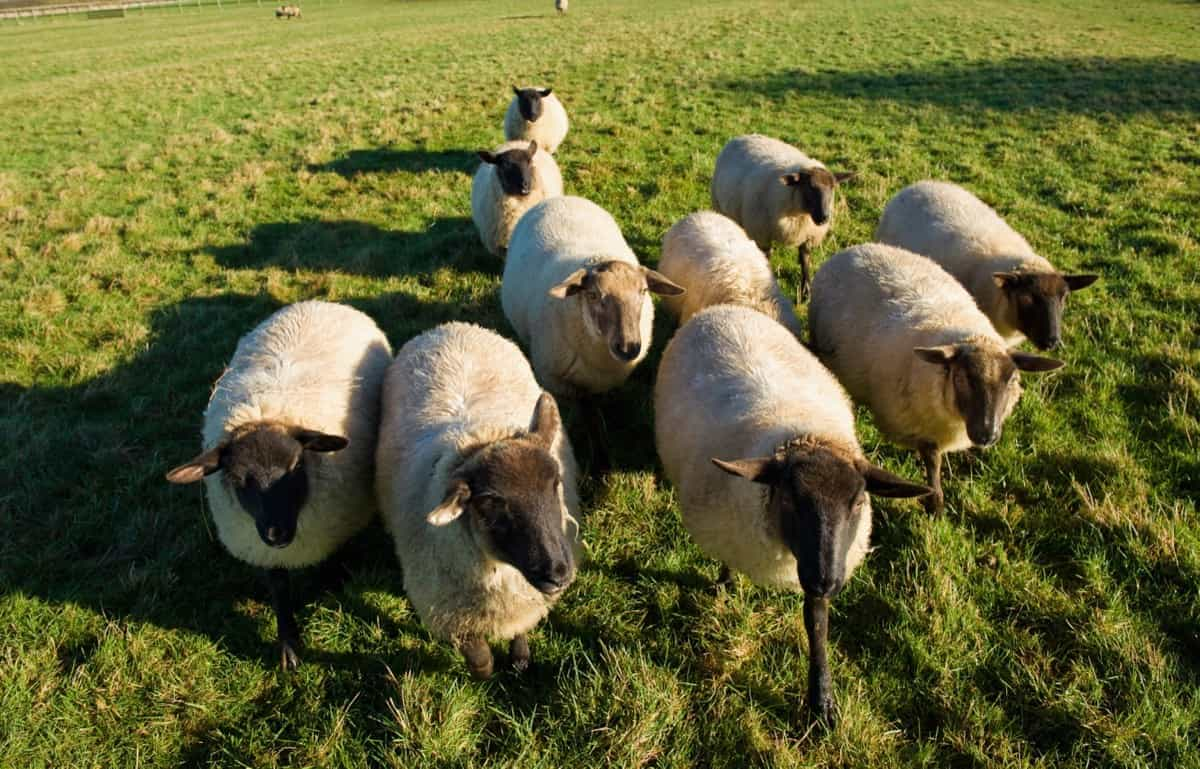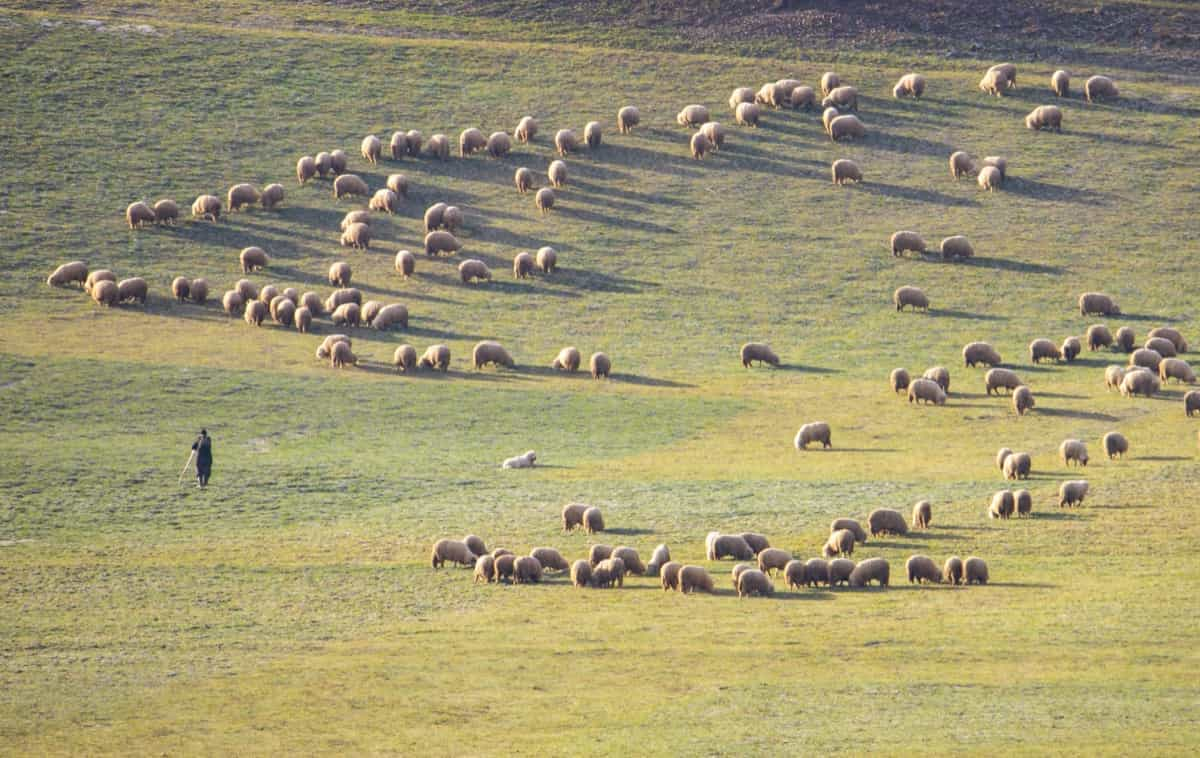Hampshire sheep are a popular breed known for their excellent meat production and distinctive appearance. Here are some key characteristics, origin, size, weight, price, lifespan, and potential disadvantages of Hampshire sheep.

Key Characteristics of Hampshire Sheep Breed: A Comprehensive Overview
- Hampshire Sheep feature distinct black faces, ears, and legs, providing a striking contrast to their white woolly coat.
- One of the defining characteristics of Hampshire sheep is their clean, alert, and bold appearance, with a black face devoid of wool.
- Hampshire Sheep traits a medium-to-large frame with a deep, wide body, showcasing robust muscling ideal for meat production.
- Medium-sized ears are carried erect, contributing to their distinctive appearance.
- The fleece of Hampshire Sheep is of high quality, featuring dense, medium-grade wool that provides excellent insulation.
- Mature Hampshire rams are notably larger and heavier than ewes, emphasizing their role in meat production.
Tracing the Origin and Historical Development of Hampshire Sheep
The Hampshire sheep origin was in England during the 1800s, with its development primarily focused in the Hampshire county. Early breeders prioritized traits such as rapid growth, muscular conformation, and adaptability to diverse climates. Hampshire sheep quickly gained popularity for their exceptional carcass quality and marketability. The Hampshire Sheep history underscores its evolution as a sought-after choice for meat production.
Size and Physical Build of Hampshire Sheep: An In-Depth Analysis
When it comes to Hampshire sheep size, it is a medium to large breed renowned for its distinctive appearance and desirable physical traits. Adult rams typically weigh between 113 and 159 kg, while ewes range from 91 to 113 kg. Regarding Hampshire sheep build, it has a deep and wide body with a strong, muscular frame that contributes to their excellent meat production qualities.
These sheep are valued not only for their size and meat yield but also for their adaptability to various climates and ease of lambing. Hampshire Sheep have played a significant role in the meat industry due to their rapid growth, efficient feed conversion, and overall hardiness. By considering these Hampshire breed physical traits makes it a popular choice among farmers and producers seeking a well-rounded and productive breed.
Average Weight and Growth Rates in Hampshire Sheep
Hampshire Sheep, a breed known for its excellent meat quality, typically Adult rams weigh between 113 and 159 kg, while ewes range from 91 to 113 kg. The Hampshire growth rate is commendable, with proper nutrition and management ensuring optimal development, with lambs gaining around 200-300 grams per day on average.
In case you missed it: Merino Sheep Farming in Kenya: Raising From Scratch for Breeding to Marketing

Hampshire sheep are recognized for their muscular build and efficient feed conversion, making them popular among farmers for meat production. The Hampshire breed average weight is influenced by factors such as genetics, nutrition, and management practices.
Current Pricing Trends and Factors Influencing Hampshire Sheep Value
Hampshire sheep prices vary based on factors like age, health, and market conditions. On average, a Hampshire lamb may cost between $150 to $300, while breeding ewes can range from $200 to $500. High-quality registered Hampshire rams may command prices upwards of $500 to $1,000 or more, depending on lineage and traits.
Hampshire Sheep are valued for their meat quality and adaptability to various climates. This Hampshire breed value in the current market is often higher compared to other breeds due to their desirable characteristics. Breeders focus on improving traits such as growth rate, muscle development, and reproductive efficiency to enhance the breed’s overall value according to Hampshire Sheep market trends and demand.
Understanding the Lifespan and Aging Process of Hampshire Sheep
The Hampshire sheep lifespan can vary based on several factors, including genetics, nutrition, healthcare, and living conditions. On average, Hampshire sheep have a lifespan of around 8 to 12 years, but many factors can influence their longevity. Proper nutrition is crucial for the Hampshire sheep longevity and overall health. Adequate access to clean water and proper grazing or feeding practices contribute to their well-being.
Regarding Hampshire Sheep aging, During the first year, their fleece gradually transforms into a coarser texture, gaining the characteristic dark face markings that distinguish the breed. By the age of two, Hampshire sheep are fully mature, displaying robust bodies and impressive horn curls in rams. Their wool continues to thicken and develop a glossy appearance. As they age beyond three years, Hampshire sheep contribute significantly to the agricultural landscape, serving as prolific breeders and adaptable foragers.
Identifying Common Disadvantages in Raising Hampshire Sheep
- One of the Hampshire sheep disadvantages is that they are prone to heat stress, making them less suitable for hot climates.
- They require ample grazing space, making them less suitable for small or crowded farms.
- Hampshire sheep have high nutritional needs, leading to increased feeding costs.
- They may be more susceptible to certain parasites, which is one of the Hampshire breed challenges that farmers will face, requiring vigilant management.
- Rams can exhibit aggressive behavior, posing a challenge for handling and care.
- Hampshire sheep breeding requires expertise, limiting accessibility for novice farmers.
- Hampshire wool may not meet the standards of finer wool breeds, and the market demand for Hampshire sheep can be inconsistent, affecting profitability, which are the major Hampshire sheep-raising issues.
Nutritional Requirements and Feeding Strategies for Hampshire Sheep
Hampshire sheep nutrition plays a vital role in optimal growth and health. A diet rich in high-quality forages, such as alfalfa and clover, provides essential nutrients like protein and fiber. Hampshire breed diet should also consist of supplemental grains, like barley or corn, to help meet energy requirements, while mineral supplements support bone development and overall well-being. Adequate access to clean water is crucial. Additionally, adjusting Hampshire Sheep feeding based on life stages, such as lambing or gestation, ensures reproductive success.
| Age | Feed Type | Quantity/Day |
| Lamb | Milk or milk replacer, starter pellets | Follow the guidelines on the package |
| Weanling | Growing pellets, good quality hay | 1-2% of body weight |
| Yearling | Pelleted feed, good quality forage | 2-3% of body weight |
| Adult | Balanced sheep feed, hay, or pasture | 2-3% of body weight |
In case you missed it: Sheep Farming in Uganda: Raising from Scratch for Breeding to Marketing

Comparing Hampshire Sheep to Other Breeds: Strengths and Weaknesses
Hampshire Sheep are renowned for their distinctive black faces and legs, making them easily identifiable. Coming to Hampshire Sheep comparison with other breeds, Hampshire breed strengths lie in their exceptional meat quality, with well-marbled, flavorful cuts.
Hampshire Sheep are known for their rapid growth and efficient feed conversion, making them economically advantageous for meat production. Additionally, they adapt well to various climates and are prized for their hardiness. However, their susceptibility to internal parasites, which may require careful management, is one of the Hampshire breed weaknesses.
Breeding Practices and Genetic Health of Hampshire Sheep
The Hampshire breed genetics focus on muscularity, rapid growth, and a distinctive black face and legs. Breeders aim to improve carcass conformation, wool quality, and maternal instincts. Hampshire sheep’s reproductive health is commendable, with a high lambing percentage and good mothering abilities. Monitoring nutrition, vaccination, and regular veterinary care ensures optimal reproductive performance. Additionally, in Hampshire Sheep breeding, breeders employ modern techniques such as artificial insemination to enhance genetic diversity and select superior traits.
In case you missed it: Sheep Milk Production: Lactation Period, Uses, Benefits, Price, and Dairy Sheep Breeds

Conclusion
Hampshire sheep are a valuable breed known for their meat production qualities, adaptability, and docility. While they may not be the top choice for wool production, their overall characteristics make them a popular choice for farmers focused on meat production. Proper management and care can help overcome potential disadvantages, allowing farmers to capitalize on the breed’s strengths in a diverse range of farming environments.
Note: The images presented in this post are intended solely for representation purposes. The images are meant to serve as visual aids and should not be relied upon as accurate representations of their real-life counterparts.
- Profitable Village Farming Business Ideas in 2024
- High-Yield Aquaculture: Fast-Growing Fish for Farming
- Effective Fish Pond Construction Techniques for Beginners
- Irrigation and Water Management in Pineapple Farming
- Blossom to Harvest: Mastering Flowering and Pollination in Papaya Farming
- Pig Fattening Essentials: From Selection to Sale for Beginners
- Raising Wagyu Cattle: A Complete Guide for Premium Beef Production
- Soil Types and Their Water Holding Capacity
- Optimizing Irrigation Schedules for Coconut Groves for Enhanced Yield
